- Clone
- GL-1 (See other available formats)
- Regulatory Status
- RUO
- Other Names
- B7-2, B70, Ly-58
- Isotype
- Rat IgG2a, κ
- Ave. Rating
- Submit a Review
- Product Citations
- publications
CD86 is an 80 kD immunoglobulin superfamily member also known as B7-2, B70, and Ly-58. CD86 is expressed on activated B and T cells, macrophages, dendritic cells, and astrocytes. CD86, along with CD80, is a ligand of CD28 and CD152 (CTLA-4). CD86 is expressed earlier in the immune response than CD80. CD86 has also been shown to be involved in immunoglobulin class-switching and triggering of NK cell-mediated cytotoxicity. CD86 binds to CD28 to transduce co-stimulatory signals for T cell activation, proliferation, and cytokine production. CD86 can also bind to CD152, also known as CTLA-4, to deliver an inhibitory signal to T cells.
Product DetailsProduct Details
- Verified Reactivity
- Mouse
- Antibody Type
- Monoclonal
- Host Species
- Rat
- Immunogen
- LPS-activated CBA/Ca mouse splenic B cells
- Formulation
- Phosphate-buffered solution, pH 7.2, containing 0.09% sodium azide
- Preparation
- The antibody was purified by affinity chromatography and conjugated with Spark Blue™ 574 under optimal conditions.
- Concentration
- 0.2 mg/mL
- Storage & Handling
- The antibody solution should be stored undiluted between 2°C and 8°C, and protected from prolonged exposure to light. Do not freeze.
- Application
-
FC
- Recommended Usage
-
Flexi-Fluors™ are provided at a standard 0.2 mg/mL concentration. We recommend titrating this reagent to determine the optimal concentration for each application. For many flow cytometry applications, conjugated antibodies perform well at concentrations ranging from 0.03 to 1.0 µg per million cells in 100 µL. We recommend testing a range of concentrations starting from 10 µg/mL.
For example, make five 1:1 serial dilutions of the 0.2 mg/mL antibody. Add 5 µL of each dilution (including the undiluted antibody) to 100 µL of cells (at 107 cells/mL) to test six concentrations -- 1.0, 0.5, 0.25, 0.125, 0.06, and 0.03 µg per million cells in 100 µL volume. Compare staining patterns or create a titration curve using the MFI or staining index to determine the optimal concentration.
* Spark Blue™ 574 has a maximum excitation of 506 nm and a maximum emission of 574 nm. - Excitation Laser
-
Blue Laser (488 nm)
- Application Notes
-
The GL-1 antibody can block the mixed lymphocyte reaction in vitro and has been shown to inhibit the priming of cytotoxic T lymphocytes in vivo (along with antibodies against B7-1). Additional reported applications (for the relevant formats) include: immunoprecipitation1, immunohistochemical staining of acetone-fixed frozen sections2,6, immunofluorescence microscopy, and in vivo and in vitro blocking of T cell responses1-6. GL-1 is not suitable for immunohistochemical staining of formalin-fixed paraffin sections. The Ultra-LEAF™ purified antibody (Endotoxin < 0.01 EU/µg, Azide-Free, 0.2 µm filtered) is recommended for functional assays (Cat. No. 105051-105056).
- Additional Product Notes
-
For more information about Flexi-Fluors™, visit our Flexi-Fluor™ page and review FAQs associated with this product line.
-
Application References
(PubMed link indicates BioLegend citation) -
- Hathcock KS, et al. 1993. Science 262:905. (Block, IP)
- Inaba KM, et al. 1994. J. Exp. Med. 180:1849. (Block, IHC)
- Hathcock KS, et al. 1994. J. Exp. Med. 180:631. (Block)
- Krummel MF, et al. 1995. J. Exp. Med. 182:459. (Block)
- Liu Y, et al. 1997. J. Exp. Med. 185:251. (Block)
- Herold KC, et al. 1997. J. Immunol. 158:984. (Block, IHC)
- Shih FF, et al. 2006. J. Immunol. 176:3438. (FC)
- Lawson BR, et al. 2007. J. Immunol. 178:5366.
- Turnquist HR, et al. 2007. J. Immunol. 178:7018.
- Klinger MB, et al. 2007. Am. J. Physiol. Requl. Integr. Comp. Physiol. 293:R677. PubMed
- de Verteuil DA, et al. 2014. J Immunol. 193:1121. PubMed
- RRID
-
AB_3662512 (BioLegend Cat. No. 285172)
Antigen Details
- Structure
- Ig superfamily, 80 kD
- Distribution
-
B cells and T cells (upregulated upon activation), macrophages, dendritic cells, and astrocytes
- Function
- T cell costimulation, Ig class-switching, NK cell cytotoxicity
- Ligand/Receptor
- CD28, CD152 (CTLA-4)
- Cell Type
- Astrocytes, B cells, Dendritic cells, Macrophages, T cells, Tregs
- Biology Area
- Cell Biology, Costimulatory Molecules, Immunology, Neuroscience, Neuroscience Cell Markers
- Molecular Family
- CD Molecules, Immune Checkpoint Receptors
- Antigen References
-
1. Barclay A, et al. 1997. The Leukocyte Antigen FactsBook Academic Press.
2. Hathcock KS, et al. 1993. Science 262:905.
3. Freeman GJ, et al. 1993. Science 262:907.
4. Carreno BM, et al. 2002. Annu. Rev. Immunol. 20:29. - Gene ID
- NA
- UniProt
- View information about CD86 on UniProt.org
Related FAQs
- What are Flexi-Fluors?
-
Flexi-Fluors are rapidly made-to-order conjugated antibodies. The technology, manufacturing processes, and specifications used to create Flexi-Fluors are the same as our regular catalog products. However, the optimal concentration and performance of each Flexi-Fluor must be determined by the customer.
- How quickly will I receive my order?
-
We aim to ship Flexi-Fluors within 2-3 weeks of receipt of your order. However, depending on your location, shipping times may vary.
- How are Flexi-Fluors different from regular catalog products?
-
Flexi-Fluors are made on demand, specifically for you. Flexi-Fluors are manufactured using the same high-quality standards, and specifications as other catalog products. For faster delivery, Flexi-Fluors are not tested by flow cytometry to determine optimal concentrations or evaluate performance. This testing needs to be performed by the customer.
- How do I determine the optimal concentration for using my Flexi-Fluor? How should I titrate my antibody?
-
Flexi-Fluors are provided at a standard 0.2 mg/mL concentration. We recommend that you titrate your antibody to determine the optimal concentration to use for your application. For many flow cytometry applications, conjugated antibodies perform well at concentrations ranging from 0.03 to 1.0 µg per million cells in 100 µL volume. We recommend that you test a range of concentrations starting from 10 µg/mL.
For example, make five 1:1 serial dilutions of your 0.2 mg/mL antibody. Add 5 µL of each dilution (including the undiluted antibody) to 100 µL of cells (at 107 cells/ml) to test six concentrations - 1.0, 0.5, 0.25, 0.125, 0.06, and 0.03 µg per million cells in 100 µL volume. Compare staining patterns or create a titration curve using the MFI or staining index to determine the optimal concentration.
- I can’t find the antibody-dye combination that I need. When will it be available?
-
We continuously update our catalog, introducing scores of new products every month. Please get in touch with our Technical Service team for an update on new products or recommendations for suitable alternatives to complete your panel. Or contact Custom Solutions to inquire about our affordable custom conjugation services.
- I need help to validate the performance of my Flexi-Fluor. Who should I contact?
-
Please get in touch with Technical Service for assistance.
- Can I order more than 50 μg of a Flexi-Fluor?
-
Yes, you can order multiple vials of the same Flexi-Fluor products. We cannot guarantee, however, that these vials will be bottled from the same lot. For bulk single-lot orders, contact our Custom Solutions team.
- What is the expiration date of my Flexi-Fluor?
-
Expiration dates can be found on the vial label or by using our CoA lookup tool.
Other Formats
View All CD86 Reagents Request Custom ConjugationCompare Data Across All Formats
This data display is provided for general comparisons between formats.
Your actual data may vary due to variations in samples, target cells, instruments and their settings, staining conditions, and other factors.
If you need assistance with selecting the best format contact our expert technical support team.
-
Brilliant Violet 650™ anti-mouse CD86
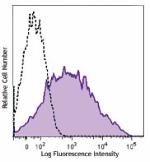
LPS-stimulated (3 days) C57BL/6 mouse splenocytes were stain... -
Biotin anti-mouse CD86

C57BL/6 mouse splenocytes stained with biotinylated GL-1,fol... -
FITC anti-mouse CD86
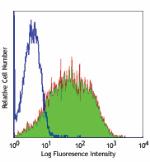
LPS-stimulated (3 days) C57BL/6 mouse splenocytes stained wi... -
PE anti-mouse CD86
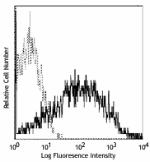
LPS (3-day) stimulated BALB/c mouse splenocytes stained with... -
Purified anti-mouse CD86
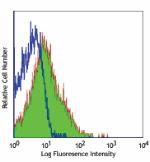
C57BL/6 mouse splenocytes stained with purified GL-1,followe... -
Brilliant Violet 605™ anti-mouse CD86
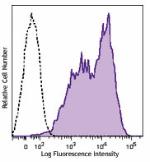
LPS-stimulated (3 days) C57BL/6 mouse splenocytes were stain... -
APC anti-mouse CD86

LPS-stimulated (3 days) C57BL/6 mouse splenocytes stained wi... -
PE/Cyanine7 anti-mouse CD86
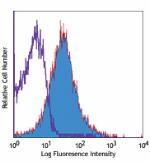
C57BL/6 mouse splenocytes stained with GL-1 PE/Cyanine7 -
Alexa Fluor® 488 anti-mouse CD86
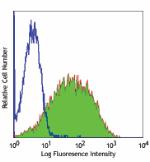
LPS-stimulated (3 days) C57BL/6 mouse splenocytes stained wi... -
Alexa Fluor® 647 anti-mouse CD86
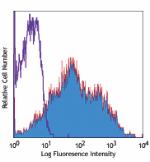
LPS-stimulated (3 days) C57BL/6 mouse splenocytes stained wi... -
Pacific Blue™ anti-mouse CD86
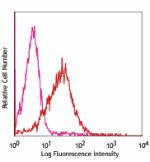
LPS (3-day) stimulated C57BL/6 mouse splenocytes stained wit... -
PE/Cyanine5 anti-mouse CD86
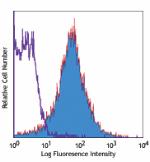
C57BL/6 mouse splenocytes stained with GL-1 PE/Cyanine5 -
Alexa Fluor® 700 anti-mouse CD86
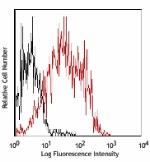
LPS-stimulated (3 days) C57BL/6 mouse splenocytes stained wi... -
PerCP/Cyanine5.5 anti-mouse CD86
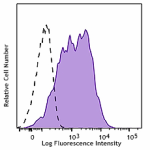
LPS-stimulated (3 days) C57BL/6 mouse splenocytes were stain... -
PerCP anti-mouse CD86
-
APC/Cyanine7 anti-mouse CD86
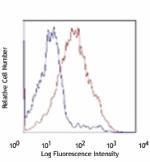
LPS-stimulated (3 days) C57BL/6 splenocytes stained with GL-... -
Brilliant Violet 421™ anti-mouse CD86
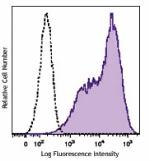
LPS-stimulated (3 days) C57BL/6 mouse splenocytes stained wi... -
Brilliant Violet 510™ anti-mouse CD86

LPS stimulated C57BL/6 mouse splenocytes (3 days) were stain... -
PE/Dazzle™ 594 anti-mouse CD86

LPS-stimulated (three days) C57BL/6 mouse splenocytes were s... -
Brilliant Violet 785™ anti-mouse CD86
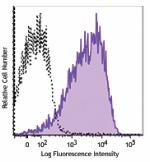
LPS stimulated C57BL/6 mouse splenocytes (3 days) were stain... -
APC/Fire™ 750 anti-mouse CD86
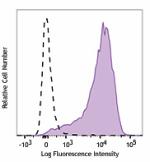
LPS-stimulated (3 days) C57BL/6 mouse splenocytes were stain... -
TotalSeq™-A0200 anti-mouse CD86
-
TotalSeq™-B0200 anti-mouse CD86
-
Ultra-LEAF™ Purified anti-mouse CD86
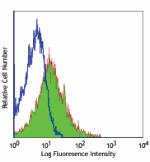
C57BL/6 mouse splenocytes stained with Ultra-LEAF™ purified ... -
TotalSeq™-C0200 anti-mouse CD86
-
Spark Blue™ 574 anti-mouse CD86 (Flexi-Fluor™)
-
Spark PLUS B550™ anti-mouse CD86

C57BL/6 mouse splenocytes were stained with anti-mouse CD3ε ... 
LPS-stimulated (3 days) C57BL/6 mouse splenocytes were stain...
 Login / Register
Login / Register 













Follow Us